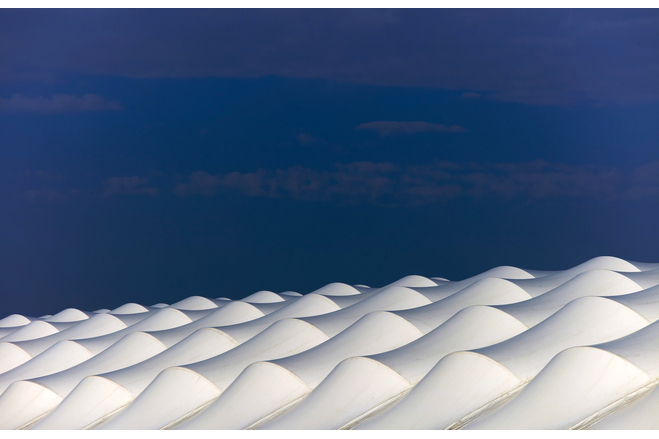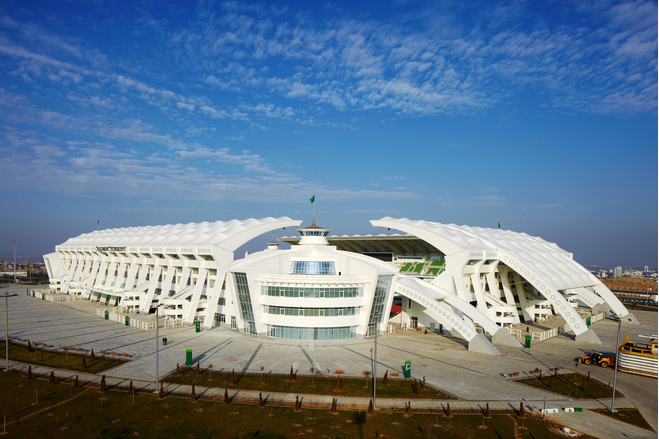Ashgabat Stadium
General information
-
Location address
Ashgabat
-
Location country
Turkmenistan
-
Year of construction
2011
-
Function of building
Sport
-
Degree of enclosure
Open structure
-
Climatic zone
Polar - very cold and dry all year
-
Number of layers
mono-layer
-
Primary function of the tensile structure
- Rain protection
- Sun protection
Description
Within the 20.000 spectator capacity Ashgabat stadium complex steel roof is covered with
an interesting membrane system. The stadium roof is solved as a cantilever steel truss. The cantilever steel truss is interconnected with cross vaults which are supporting the membrane. Arch membranes are frequently installed as ring rope roofs for stadiums, with the arch being supported with a hinge on the carrier cable and the warp direction of the fabric mostly running at right angles to the arch. When several arches are arranged next to each other, the membrane is mostly pulled in along the arch from rope truss to rope truss. The installation of the arch and the
pulling in and tensioning of the membrane are mostly done field by panel from scaffold hanging under
the rope trusses or by abseiling. To stabilize the arches, temporary ropes tensioned diagonally in three dimensions can be installed during the erection. When pulling on the membrane in the arch direction, it is first anchored to the end points, in order to mount the edges to the truss. After pulling the membrane to the opposite side, it can be successively tensioned against the truss starting in the middle and fixed by mounting the edge elements. The fabric, folded longitudinally, was lifted transverse to the arch trusses and unfolded on both sides over the secondary arches. After fixing the membrane to the corner points, the clamping plates were installed along the edges of the arch trusses. The introduction of the pretension was done at right angles to the arch truss by moving the preassembled keder rail sections. This was done with the help of lashing straps, with the force being introduced successively starting from the middle of the arch truss. After the edge rope, which had already been pulled in, had been tensioned, the edge of the surface was finally tensioned through the webbing fabricated into the corners and fixed by bolting the ropes intended to secure against wind uplift to the crown of the arch.
Description of the environmental conditions
Material of the cover
-
Cable-net/Fabric/Hybrid/Foil
Fabric
-
Material Fabric/Foil
NAIZIL PLUS COVER TYPE III
Main dimensions and form
-
Covered surface (m2)
25000
Duration of use
-
Temporary or permanent structure
Permanent
Involved companies
-
Architects
Design Group
-
Engineers
Tensaform Membrane Structures Industry & Trade Inc.
-
Contractors
Polimeks Ýnþaat A.Þ.
-
Suppliers
Naizil spa
Editor
-
Editor
Evi Corne



